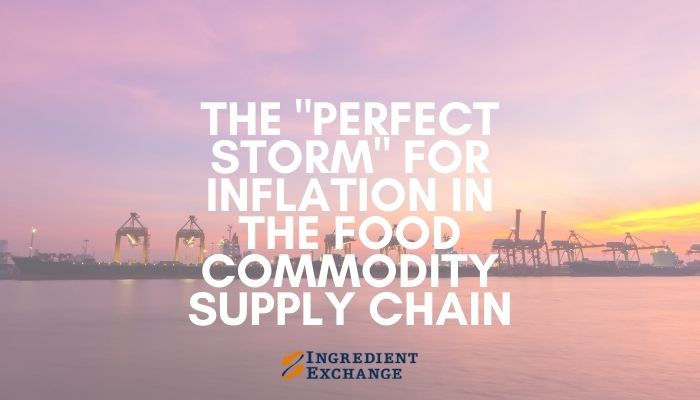Tune in to any major media outlet, and you will find reports of record shipping container backlogs. Off the coast of Los Angeles, one of North America’s largest shipping ports, seventy-plus vessels are waiting to be unloaded.
How does this backlog affect the food supply chain?
The resulting backlog has impacted shipping rates into U.S. ports and is hitting almost every food commodity that comes into the United States.
For example, the cost to move a container of sugar from Mexico has increased 400% from $2,000 to $8,000 for a 20′ container.
Domestic sugar manufacturers are facing shortages as a result of reduced sugar imports.
Refined sugar prices are up 17% year over year.
Shortages and price surges are worse for products coming out of China. Spot rates for a 20′ container from China to the Western United States saw a hefty quote of $20,000.
Moving the imported goods along with goods produced on the coast to the rest of the country is a challenge. Freight rates from the West coast are at all-time highs.
A significant contributor to the rate increase is U.S. oil price that are at a seven year high of $77.62 a barrel for West Texas Intermediate.
Many buyers are looking to source food commodities as locally as possible to reduce logistical costs and ensure timely and consistent supply.
The drive to shorten supply chains comes at a cost; rents and labor are higher in the United States, but the adoption of just-in-time inventory with a global supply chain has proved disastrous in a pandemic.
The corn-wet milling industry offers another illustration of what we see across the food industry. This year, the industry has had supply challenges due to unexpected plant shutdowns and a sharp increase in demand due to changing food and beverage trends.
Imports from China have either been denied due to high shipping costs or delayed. Buyers are scrambling to cover shortages and build safety stocks as they know supplies are limited. As a result, price increases in 2022 range from 17% to 35%, depending on the commodity.
As one vendor stated to us, “You have to decide if you are going to be a have or a have-not in 2022.” If you need these products to run your facility, this is not a comfortable negotiating position.
For many, this is the definition of “transitory” or temporary inflation, and prices will come back down as supply chains normalize. However, some of the inflation we are seeing is sticky.
How are shortages being affected by labor?
Manufacturers are reporting they are struggling to hire and retain labor.
Plants are running at a reduced capacity because they only have enough labor to run one shift four days per week. This labor shortage causes a trickle effect in denied sales, and higher prices as supply becomes constrained.
Some manufacturers have offered 3 and 4 figure signing bonuses to attract workers, and others are increasing wages to existing employees to retain their workforce. Our sample size is small, and the data is anecdotal, but we have heard of wage increases between 5% to 15% in 2021. It’s hard to imagine an employer asking an employee to take a wage cut when the labor market normalizes.
What can you do?
- Stay tuned in to the market on critical materials and ingredients. Have multiple suppliers and a healthy safety stock.
- Contract early; you want a chair to sit in when the music stops.
- Spread the pain, offer your vendors a long-term deal and take price increases over time. Consider partnering with a firm that has multiple vendors and risk management tools.
- Work on inventive ways to compete for labor.
- Raise prices.
How about you? What are you experiencing?
We would like to hear about what you are experiencing. Are the prices for your ingredients, packaging, freight, fuel, and labor rising? What are you doing to mitigate the impact of these increases? What trends do you think are here to stay, and what do you think will happen when supply chains return to normal?
